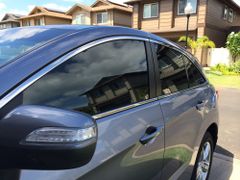How Dark Can Car Windows Be Tinted in Hawaii?

Window tinting increases safety while out on the road, reducing the effects of the sun’s rays and protecting drivers from glare. However, there are few legal limits you need to observe. Learn more about the restrictions below to ensure you follow the law.
What Are the Requirements for Window Tinting?
The restrictions depend on the type of vehicle. For a sedan, the tint should allow at least 35% of sunlight in each of the windows. For larger SUVs and vans, the front side windows must allow for at least 35% of sunlight. The back side and rear windows can feature any level of darkness that you desire.
 Windshields on any vehicle can have a non-reflective tint along the top four inches of the material. If you’re looking to add reflection to the tint, avoid any metallic or mirrored appearances.
Windshields on any vehicle can have a non-reflective tint along the top four inches of the material. If you’re looking to add reflection to the tint, avoid any metallic or mirrored appearances.
After investing in window tinting, secure a certificate of compliance from your installer and keep it in the vehicle at all times.
Why Was This Law Made?
The crackdown on automotive window tinting is to increase safety for police officers and drivers alike. Before, authorities couldn’t see what drivers were doing, which made it difficult to anticipate how to handle each situation. Restricting the tint avoids any confusion and ensures people comply with the law while driving.
There are no medical exceptions for darkening the windows past the legal limit. If you aren’t in compliance, you could receive a fine of $250 to $500 and will have to secure an immediate correction.
Maintain safety while out on the road by working with Ohana Tinting of Kapolei, HI. The family-owned and -operated tint shop has provided quality auto, residential, and commercial tinting services since 2013. They back every installation with a manufacturer warranty and treat every customer like family. Set up a window tinting appointment by calling (808) 636-6551, or visit their website for additional information on their products.
About the Business
Have a question? Ask the experts!
Send your question

